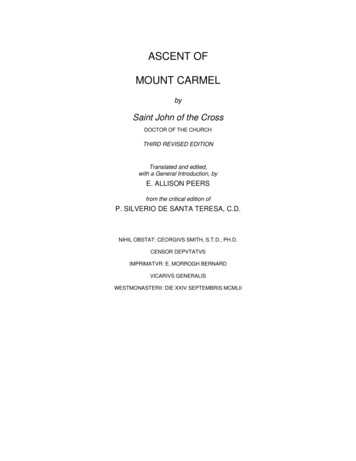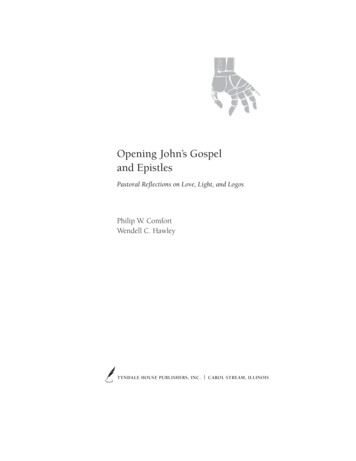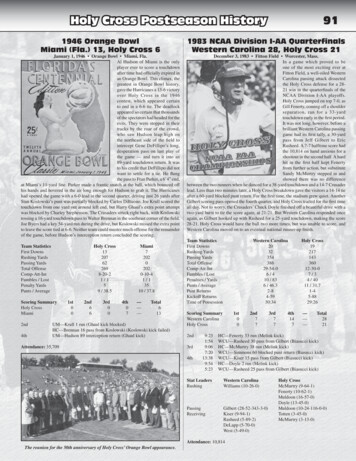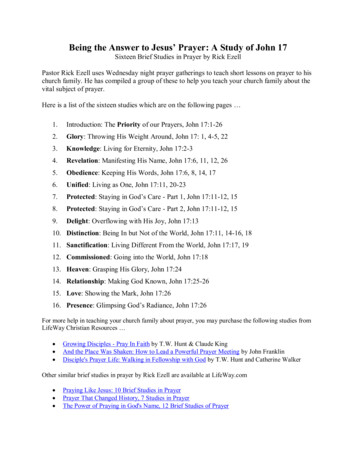
Transcription
ASCENT OFMOUNT CARMELbySaint John of the CrossDOCTOR OF THE CHURCHTHIRD REVISED EDITIONTranslated and edited,with a General Introduction, byE. ALLISON PEERSfrom the critical edition ofP. SILVERIO DE SANTA TERESA, C.D.NIHIL OBSTAT: CEORGIVS SMITH, S.T.D., PH.D.CENSOR DEPVTATVSIMPRIMATVR: E. MORROGH BERNARDVICARIVS GENERALISWESTMONASTERII: DIE XXIV SEPTEMBRIS MCMLII
TO THEDISCALCED CARMELITES OF CASTILE,WITH ABIDING MEMORIES OF THEIR HOSPITALITY AND KINDNESSIN MADRID, AVILA AND BURGOS,BUT ABOVE ALL OF THEIR DEVOTION TOSAINT JOHN OF THE CROSS,I DEDICATE THIS TRANSLATION2
CONTENTSPREFACE TO THE ELECTONIC EDITION . 6TRANSLATOR'S PREFACE . 11TO THE SECOND EDITION . 11AN OUTLINE OF THE LIFE OF ST. JOHN OF THE CROSS . 13GENERAL INTRODUCTION TO THE WORKS OF ST. JOHN OF THE CROSS . 16DATES AND METHODS OF COMPOSITION. . 16GENERAL CHARACTERISTICS . 16OUTSTANDING QUALITIES AND DEFECTS OF THE SAINT'S STYLE . 27DIFFUSION OF THE WRITINGS OF ST. JOHN OF THE CROSS -- LOSS OF THEAUTOGRAPHS -- GENERAL CHARACTERISTICS OF THE MANUSCRIPTS . 29INTEGRITY OF THE SAINT'S WORK -- INCOMPLETE CONDITION OF THE'ASCENT' AND THE 'NIGHT' -- DISPUTED QUESTIONS . 32HISTORY OF THE PUBLICATION OF ST. JOHN OF THE CROSS'S WRITINGS -THE FIRST EDITION. 36DENUNCIATION OF THE 'WORKS' TO THE INQUISITION -- DEFENCE OF THEMMADE BY FR. BASILO PONCE DE LEîN -- EDITIONS OF THE SEVENTEENTHAND EIGHTEENTH CENTURIES . 39NEW DENUNCIATIONS AND DEFENCES -- FRAY NICOLçS DE JESòS MARêA -THE CARMELITE SCHOOL AND THE INQUISITION. 42FURTHER HISTORY OF THE EDITIONS -- P. ANDRƒS DE LA ENCARNACIîN -EDITIONS OF THE NINETEENTH AND TWENTIETH CENTURIES. 44ASCENT OF MOUNT CARMEL . 48INTRODUCTION . 48ARGUMENT . 54BOOK THE FIRST . 59CHAPTER I . 59CHAPTER II . 60CHAPTER III . 61CHAPTER IV. 63CHAPTER V. 66CHAPTER VI. 69CHAPTER VII. 72CHAPTER VIII. 73CHAPTER IX. 76CHAPTER X. 79CHAPTER XI. 80CHAPTER XII. 83CHAPTER XIII. 853
CHAPTER XIV . 87CHAPTER XV . 88BOOK THE SECOND . 90CHAPTER I . 90CHAPTER II . 91CHAPTER III . 92CHAPTER IV. 94CHAPTER V. 97CHAPTER VI. 101CHAPTER VII. 103CHAPTER VIII. 107CHAPTER IX. 109CHAPTER X. 111CHAPTER XI. 112CHAPTER XII. 116CHAPTER XIII. 119CHAPTER XIV . 121CHAPTER XV . 127CHAPTER XVI . 129CHAPTER XVII . 133CHAPTER XVIII . 137CHAPTER XIX . 140CHAPTER XX . 146CHAPTER XXI . 148CHAPTER XXII . 154CHAPTER XXIII . 161CHAPTER XXIV. 163CHAPTER XXV. 166CHAPTER XXVI. 167CHAPTER XXVII. 173CHAPTER XXVIII. 175CHAPTER XXIX. 176CHAPTER XXX. 180CHAPTER XXXI. 182CHAPTER XXXII. 184BOOK THE THIRD. 187CHAPTER I . 187CHAPTER II . 187CHAPTER III . 192CHAPTER IV. 194CHAPTER V. 195CHAPTER VI. 195CHAPTER VII. 197CHAPTER VIII. 197CHAPTER IX. 198CHAPTER X. 2004
CHAPTER XI. 200CHAPTER XII. 201CHAPTER XIII. 202CHAPTER XIV . 206CHAPTER XV . 206CHAPTER XVI . 208CHAPTER XVII . 209CHAPTER XVIII . 210CHAPTER XIX . 212CHAPTER XX . 216CHAPTER XXI . 218CHAPTER XXII . 219CHAPTER XXIII . 222CHAPTER XXIV. 223CHAPTER XXV. 225CHAPTER XXVI. 226CHAPTER XXVII. 228CHAPTER XXVIII. 230CHAPTER XXIX. 232CHAPTER XXX. 234CHAPTER XXXI. 235CHAPTER XXXII. 238CHAPTER XXXIII. 239CHAPTER XXXIV . 240CHAPTER XXXV . 240CHAPTER XXXVI . 243CHAPTER XXXVII . 244CHAPTER XXXVIII . 245CHAPTER XXXIX . 247CHAPTER XL. 248CHAPTER XLI. 249CHAPTER XLII. 250CHAPTER XLIII. 251CHAPTER XLIV . 252CHAPTER XLV . 2545
PREFACE TO THE ELECTONIC EDITIONThis electronic edition (v 0.9) has been scanned from an uncopyrighted 1962Image Books second edition of the Ascent and is therefore in the public domain. Theentire text and some of the footnotes have been reproduced. Nearly 1000 footnotes(and parts of footnotes) describing variations among manuscripts have been omitted.Page number references in the footnotes have been changed to chapter and sectionwhere possible. This edition has been proofread once, but additional errors may remain.Harry PlantingaUniversity of Pittsburghplanting@cs.pitt.eduJuly 1, 1994.6
FOR at least twenty years, a new translation of the works of St. John of the Cross hasbeen an urgent necessity. The translations of the individual prose works now in generaluse go back in their original form to the eighteen-sixties, and, though the later editionsof some of them have been submitted to a certain degree of revision, nothing but acomplete retranslation of the works from their original Spanish could be satisfactory. Forthis there are two reasons.First, the existing translations were never very exact renderings of the originalSpanish text even in the form which held the field when they were first published. Theirgreat merit was extreme readableness: many a disciple of the Spanish mystics, who isunacquainted with the language in which they wrote, owes to these translations thecomparative ease with which he has mastered the main lines of St. John of the Cross'steaching. Thus for the general reader they were of great utility; for the student, on theother hand, they have never been entirely adequate. They paraphrase difficultexpressions, omit or add to parts of individual sentences in order (as it seems) tofacilitate comprehension of the general drift of the passages in which these occur, andfrequently retranslate from the Vulgate the Saint's Spanish quotations from HolyScripture instead of turning into English the quotations themselves, using the textactually before them.A second and more important reason for a new translation, however, is thediscovery of fresh manuscripts and the consequent improvements which have beenmade in the Spanish text of the works of St. John of the Cross, during the presentcentury. Seventy years ago, the text chiefly used was that of the collection known as theBiblioteca de Autores Espa–oles (1853), which itself was based, as we shall later see,upon an edition going back as far as 1703, published before modern methods of editingwere so much as imagined. Both the text of the B.A.E. edition and the unimportantcommentary which accompanied it were highly unsatisfactory, yet until the beginning ofthe present century nothing appreciably better was attempted.In the last twenty years, however, we have had two new editions, each basedupon a close study of the extant manuscripts and each representing a great advanceupon the editions preceding it. The three-volume Toledo edition of P. Gerardo de SanJuan de la Cruz, C.D. (1912-14), was the first attempt made to produce an accurate textby modern critical methods. Its execution was perhaps less laudable than itsconception, and faults were pointed out in it from the time of its appearance, but itserved as a new starting-point for Spanish scholars and stimulated them to a newinterest in St. John of the Cross's writings. Then, seventeen years later, came themagnificent five-volume edition of P. Silverio de Santa Teresa, C.D. (Burgos, 1929-31),which forms the basis of this present translation. So superior is it, even on the mostcasual examination, to all its predecessors that to eulogize it in detail is superfluous. It isfounded upon a larger number of texts than has previously been known and it collatesthem with greater skill than that of any earlier editor. It can hardly fail to be the standardedition of the works of St. John of the Cross for generations.Thanks to the labours of these Carmelite scholars and of others whose findingsthey have incorporated in their editions, Spanish students can now approach the workof the great Doctor with the reasonable belief that they are reading, as nearly as maybe, what he actually wrote. English-reading students, however, who are unable tomaster sixteenth-century Spanish, have hitherto had no grounds for such a belief. Theycannot tell whether, in any particular passage, they are face to face with the Saint's own7
words, with a translator's free paraphrase of them or with a gloss made by some latercopyist or early editor in the supposed interests of orthodoxy. Indeed, they cannot besure that some whole paragraph is not one of the numerous interpolations which has itsrise in an early printed edition -- i.e., the timorous qualifications of statements whichhave seemed to the interpolator over-bold. Even some of the most distinguished writersin English on St. John of the Cross have been misled in this way and it has beenimpossible for any but those who read Spanish with ease to make a systematic andreliable study of such an important question as the alleged dependence of Spanishquietists upon the Saint, while his teaching on the mystical life has quite unwittinglybeen distorted by persons who would least wish to misrepresent it in any particular.It was when writing the chapter on St. John of the Cross in the first volume of myStudies of the Spanish Mystics (in which, as it was published in 1927, I had not theadvantage of using P. Silverio's edition) that I first realized the extent of the harmcaused by the lack of an accurate and modern translation. Making my own versions ofall the passages quoted, I had sometimes occasion to compare them with those of othertranslators, which at their worst were almost unrecognizable as versions of the sameoriginals. Then and there I resolved that, when time allowed, I would make a freshtranslation of the works of a saint to whom I have long had great devotion -- to whom,indeed, I owe more than to any other writer outside the Scriptures. Just at that time Ihappened to visit the Discalced Carmelites at Burgos, where I first met P. Silverio, andfound, to my gratification, that his edition of St. John of the Cross was much nearerpublication than I had imagined. Arrangements for sole permission to translate the newedition were quickly made and work on the early volumes was begun even before thelast volume was published.IIThese preliminary notes will explain why my chief preoccupation throughout theperformance of this task has been to present as accurate and reliable a version of St.John of the Cross's works as it is possible to obtain. To keep the translation, line by line,au pied de la lettre, is, of course, impracticable: and such constantly occurring Spanishhabits as the use of abstract nouns in the plural and the verbal construction 'ir presentparticiple' introduce shades of meaning which cannot always be reproduced. Yetwherever, for stylistic or other reasons, I have departed from the Spanish in any waythat could conceivably cause a misunderstanding, I have scrupulously indicated this in afootnote. Further, I have translated, not only the text, but the variant readings as givenby P. Silverio,1 except where they are due merely to slips of the copyist's pen or wherethey differ so slightly from the readings of the text that it is impossible to render thedifferences in English. I beg students not to think that some of the smaller changesnoted are of no importance; closer examination will often show that, however slight theymay seem, they are, in relation to their context, or to some particular aspect of theSaint's teaching, of real interest; in other places they help to give the reader an idea,which may be useful to him in some crucial passage, of the general characteristics ofthe manuscript or edition in question. The editor's notes on the manuscripts and earlyeditions which he has collated will also be found, for the same reason, to besummarized in the introduction to each work; in consulting the variants, the English1The footnotes are P. Silverio's except where they are enclosed in square brackets.8
reading student has the maximum aid to a judgment of the reliability of his authorities.Concentration upon the aim of obtaining the most precise possible rendering ofthe text has led me to sacrifice stylistic elegance to exactness where the two have beenin conflict; it has sometimes been difficult to bring oneself to reproduce the Saint's oftenungainly, though often forceful, repetitions of words or his long, cumbrous parentheses,but the temptation to take refuge in graceful paraphrases has been steadily resisted. Inthe same interest, and also in that of space, I have made certain omissions from, andabbreviations of, other parts of the edition than the text. Two of P. Silverio's fivevolumes are entirely filled with commentaries and documents. I have selected from thedocuments those of outstanding interest to readers with no detailed knowledge ofSpanish religious history and have been content to summarize the editor's introductionsto the individual works, as well as his longer footnotes to the text, and to omit such partsas would interest only specialists, who are able, or at least should be obliged, to studythem in the original Spanish.The decision to summarize in these places has been made the less reluctantlybecause of the frequent unsuitability of P. Silverio's style to English readers. Like that ofmany Spaniards, it is so discursive, and at times so baroque in its wealth of epithet andits profusion of imagery, that a literal translation, for many pages together, wouldseldom have been acceptable. The same criticism would have been applicable to anyliteral translation of P. Silverio's biography of St. John of the Cross which stands at thehead of his edition (Vol. I, pp. 7-130). There was a further reason for omitting thesebiographical chapters. The long and fully documented biography by the FrenchCarmelite, P. Bruno de JŽsus-Marie, C.D., written from the same standpoint as P.Silverio's, has recently been translated into English, and any attempt to rival this in soshort a space would be foredoomed to failure. I have thought, however, that a briefoutline of the principal events in St. John of the Cross's life would be a usefulpreliminary to this edition; this has therefore been substituted for the biographical sketchreferred to.In language, I have tried to reproduce the atmosphere of a sixteenth-century textas far as is consistent with clarity. Though following the paragraph divisions of myoriginal, I have not scrupled, where this has seemed to facilitate understanding, todivide into shorter sentences the long and sometimes straggling periods in which theSaint so frequently indulged. Some attempt has been made to show the contrastbetween the highly adorned, poetical language of much of the commentary on the'Spiritual Canticle' and the more closely shorn and eminently practical, though alwayssomewhat discursive style of the Ascent and Dark Night. That the Living Flameoccupies an intermediate position in this respect should also be clear from the style ofthe translation.Quotations, whether from the Scriptures or from other sources, have been leftstrictly as St. John of the Cross made them. Where he quotes in Latin, the Latin hasbeen reproduced; only his quotations in Spanish have been turned into English. Thefootnote references are to the Vulgate, of which the Douai Version is a direct translation;if the Authorized Version differs, as in the Psalms, the variation has been shown insquare brackets for the convenience of those who use it.A word may not be out of place regarding the translations of the poems as theyappear in the prose commentaries. Obviously, it would have been impossible to use thecomparatively free verse renderings which appear in Volume II of this translation, sincethe commentaries discuss each line and often each word of the poems. A literal version9
of the poems in their original verse-lines, however, struck me as being inartistic, if notrepellent, and as inviting continual comparison with the more polished verse renderingswhich, in spirit, come far nearer to the poet's aim. My first intention was to translate thepoems, for the purpose of the commentaries, into prose. But later I hit upon the longand metrically unfettered verse-line, suggestive of Biblical poetry in its English dress,which I have employed throughout. I believe that, although the renderings often sufferartistically from their necessary literalness, they are from the artistic standpoint at leasttolerable.IIIThe debts I have to acknowledge, though few, are very large ones. My gratitudeto P. Silverio de Santa Teresa for telling me so much about his edition before itspublication, granting my publishers the sole translation rights and discussing with me anumber of crucial passages cannot be disjoined from the many kindnesses I havereceived during my work on the Spanish mystics, which is still proceeding, from himselfand from his fellow-Carmelites in the province of Castile. In dedicating this translation tothem, I think particularly of P. Silverio in Burgos, of P. Florencio del Ni–o Jesœs inMadrid, and of P. Cris—gono de Jesœs Sacramentado, together with the Fathers of the'Convento de la Santa' in çvila.The long and weary process of revising the manuscript and proofs of thistranslation has been greatly lightened by the co-operation and companionship of P.Edmund Gurdon, Prior of the Cartuja de Miraflores, near Burgos, with whom I havefreely discussed all kinds of difficulties, both of substance and style, and who has beengood enough to read part of my proofs. From the quiet library of his monastery, as wellas from his gracious companionship, I have drawn not only knowledge, but strength,patience and perseverance. And when at length, after each of my visits, we have had topart, we have continued our labours by correspondence, shaking hands, as it were,'over a vast' and embracing 'from the ends of oppos d winds.'Finally, I owe a real debt to my publishers for allowing me to do this work withoutimposing any such limitations of time as often accompany literary undertakings. Thisand other considerations which I have received from them have made that part of thework which has been done outside the study unusually pleasant and I amcorrespondingly grateful.E. ALLISON PEERS.University of Liverpool.Feast of St. John of the Cross,November 24, 1933.NOTE. -- Wherever a commentary by St. John of the Cross is referred to, its titleis given in italics (e.g. Spiritual Canticle); where the corresponding poem is meant, it isplaced between quotation marks (e.g. 'Spiritual Canticle'). The abbreviation 'e.p.' standsfor editio princeps throughout.10
TRANSLATOR'S PREFACETO THE SECOND EDITIONDURING the sixteen years which have elapsed since the publication of the first edition,several reprints have been issued, and the demand is now such as to justify a completeresetting. I have taken advantage of this opportunity to revise the text throughout, andhope that in some of the more difficult passages I may have come nearer than before tothe Saint's mind. Recent researches have necessitated a considerable amplification ofintroductions and footnotes and greatly increased the length of the bibliography.The only modification which has been made consistently throughout the threevolumes relates to St. John of the Cross's quotations from Scripture. In translating theseI still follow him exactly, even where he himself is inexact, but I have used the DouiaVersion (instead of the Authorized, as in the first edition) as a basis for all Scripturalquotations, as well as in the footnote references and the Scriptural index in Vol. III.Far more is now known of the life and times of St. John of the Cross than whenthis translation of the Complete Works was first published, thanks principally to theHistoria del Carmen Descalzo of P. Silverio de Santa Teresa, C.D, now General of hisOrder, and to the admirably documented Life of the Saint written by P. Cris—gono deJesus Sacramentado, C.D., and published (in Vida y Obras de San Juan de la Cruz) inthe year after his unt
3 CONTENTS PREFACE TO THE ELECTONIC EDITION.6 TRANSLATOR'S PREFACE











